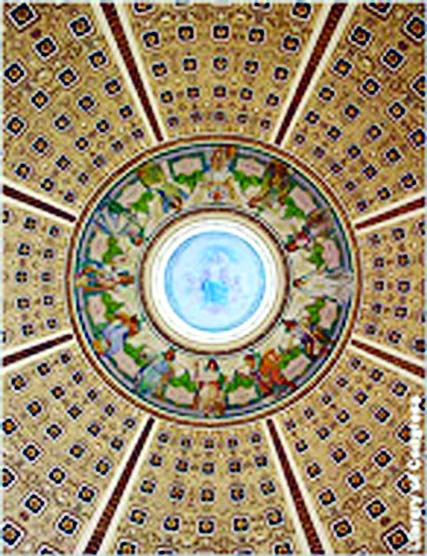
The dome of the Library of Congress reading room in Washington depicts important influences on civilization, including Islam.
The country’s founders recognized that the fragile alliance of states that made up the early United States would survive only if it could unify its diverse, competing – and at times, conflicting – religious and ethnic groups into the fold of a new, collective national identity. Without creative and inclusive solutions, the fragile nation could easily crumble in the face of sectarian divisions. The creative solution the founders devised was a Constitution that placed above all else the individual’s right to freedom of religious worship and thought. It was only fitting that a land founded upon the promise of freedom would begin first with freedom inside the heart and mind of the individual.
Almost 250 years ago this was a revolutionary concept – a risky endeavor that had no modern precedent. But, in retrospect, it is not surprising that the Constitution’s legal guarantee of freedom of thought and worship would give rise to a religiously diverse and vibrant society. And while the stories of how disparate peoples became Americans are not always free of conflict and tragedy, the ongoing narrative of America is the continuous unfolding of unity through diversity.
Zara Afridi, center right, chats with friends outside the South Asian Youth Action building in Queens, New York.
Thanks to its fundamental openness, the United States today is among the most culturally and religiously diverse countries in the world – so much so that, within 30 years, its minority populations will outnumber the majority. Without fear of encountering institutionalized discrimination, American citizens are free to practice their religion, give voice to their views and use their creative energies to pursue their personal aspirations. The result is a dynamic marketplace of ideas where all have the right to express themselves, as long as they are respectful of the rights of others.
Part of the American Mix
Like most aspects of American life, religious worship in the United States is infused with the spirit of inclusion and mutual respect. During the month of Ramadan, for example, mosques routinely open their doors to neighbors of other faiths to partake in the breaking of the fast at sundown. A couple of years ago, I had the pleasure of attending an iftar dinner at one of the oldest Jewish synagogues in Washington. The dinner was attended by religious leaders and practitioners from all the major faith traditions. Scenes like these have become common across the United States, as communities come together to share and celebrate the diverse and collective experience of what it means to be American.
Muslims in the United States contribute to the social and economic fabric of their communities. They are among the most educated and highest-income-earning groups in the country, and they participate at every level of society – from teachers, doctors, lawyers and engineers to elected officials at the highest levels of government. In fact, the very same day that I gazed upon the dome of the Library of Congress, I discovered another treasure housed in the great library. When the first American Muslim congressman, Keith Ellison, took the oath of office in 2007, he used a Quran that had belonged to Thomas Jefferson. This Quran, hand-marked with the initials “TJ,” is displayed in the library, next to Jefferson’s copy of the Old Testament.
The story of the United States began with the story of religious freedom. From the halls of government to the archives of history, it is a story that has reaffirmed itself time and again. It is a story that continues to shape the nation today.
In a world where many countries must come to terms with increasing diversity brought about by the triple forces of globalization, technology and travel, there is a lesson in the experience of the United States and the forging of American identity. It is a lesson that is embodied in the Latin words inscribed on the seal of the United States, and sums up the central theme of the American identity, “E Pluribus Unum” – Out of Many, One.

